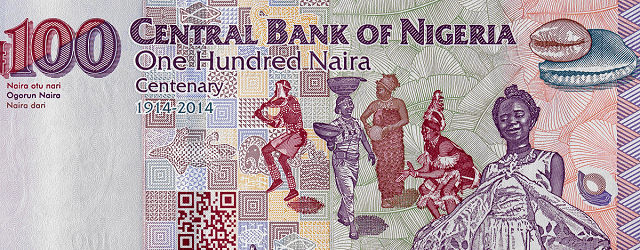Will a brutal decline in the Naira force the country to finally end its multiple-exchange-rate system?

In the five months between March and August of this year, Nigeria’s currency, the Naira, fell by nearly a fifth of its value on the official exchange rate window, from 305 to the U.S. dollar to 379 on August 21, according to data from the Central Bank of Nigeria (CNB), for a roughly 24.3% decline.
In the coming weeks or months, the Naira may be primed to lose more of its purchasing power. While it is not clear now how far the currency will fall, some close observers say it could weaken to as low as 500 Naira per 1 USD officially.
As a part of its effort to stem the Naira’s slide and reinvigorate confidence in the currency, the CNB has embarked on what it terms exchange rates unification or convergence. Critics have warned repeatedly that Nigeria’s fragmented exchange rate system—which offers multiple rates at different windows—is one of the fundamentals driving speculative demand and arbitrage pressures.
Apart from the official rate, the most prominent Naira exchange rate is the Investors’ and Exporters’ (I&E) rate, otherwise known as the NAFEX Fixing, which serves investors and exporters. One of the most liquid segments of the Nigerian foreign exchange market, it has attracted over US$95billion in inflows since its establishment in April 2017.
While the I&E window has been generally regarded as the more liberal market, the CBN devalued the NAFEX Fixing in March, driving down the prevailing rate from N366.70 to the dollar to N380.20.
Likewise, the hitherto stable bureaux de change rate—which serves individuals needing foreign exchange for personal and business travel, payment of school fees abroad and foreign medical treatment—has depreciated more than 30% over the past five months, from N360 per dollar to N475.
Supply scarcity has exacerbated the Naira’s weakness, as the CBN halted foreign exchange sales through bureaux de change in March following the closure of international airports. But market participants argue that the demand pressure is reflective of the weak supply in other segments of the FX market, forcing even corporates to buy foreign currencies for raw material imports from the bureau.
Finally, there is the parallel or “black market” rate serving the needs of multitudes who cannot easily access funds at the other windows, particularly speculators seeking to stock up on foreign currencies in anticipation of further Naira weakness.
Additionally, the low interest-rate environment and the attendant decline in yields on Naira-denominated instruments such as treasury bills and bonds have fueled the appetite of Nigeria’s high-net worth individuals and the middle class for foreign currency as an asset class for store of value and potentially higher returns. The Naira is currently selling at about 475 to a dollar in this segment of the market.
Arbitrage Opportunities
Nigeria’s multiplicity of rates has long been worrisome to the country’s officials as well as investors, the International Monetary Fund (IMF) and other international development finance institutions. The current devaluation may provide the short-term pain necessary for Nigeria to simplify the system, argues Abiola Rasaq, a Lagos-based financial analyst.
“The current situation of the foreign exchange market is an incentive for round-tripping, arbitrage, and rent-seeking,” he says, but also a near-term threat to average Nigerians should the Naira fall further at the official windows.
“A convergence is not necessarily to bring all the exchange rates to one rate,” Rasaq says, “but to narrow the current wide gaps in the multiple exchange rates to a point where the differential among the rates is not enough to support arbitrate or round-tripping.”
In other words, the system of divergent official and parallel market rates has inadvertently created opportunities that subsidize a few people, including big corporates and the elite, who can round-trip the subsidized rate or fly it abroad through middlemen, invoicing, and other unofficial mechanisms. Savvy individuals may queue up at the official window, buy U.S. dollars at the current N397 rate, then sell them at N475 on the parallel market, collecting a premium of about 20% in a matter of weeks.
Deadweight on the Economy
The result has been continued weakness and loss of market confidence, now heightened by the pandemic and other macroeconomic challenges facing the country, Razaq says.
“There is a deadweight loss in the current situation, because the system is perhaps subsidizing some segments of the economy which are neither passed through to the public nor productive,” he says. This is “perhaps manifested in the form of supply shortages of most basic raw materials and finished products as genuine and bloated trade continue to thrive at the expense of the weak fundamentals of local production.”
The discrepancy also creates a disincentive for foreign investors, who cannot bring in their capital through the backdoor despite the higher rate prevailing there since they would not receive a certificate of capital importation, which would make it difficult for them to take capital and profits out of the country.
“The recent upward adjustment of the exchange rate by the CBN is no doubt largely in response to the conditions for drawing down on the recent IMF RFI facility,” says Uche Uwaleke, a financial economist and professor of capital markets at Nasarawa State University, North-Central Nigeria.
The IMF in April provided Nigeria a $3.4 billion rapid financing instrument. The facility is meant to help the country overcome revenue shortfalls arising from this year’s fall in the price of oil. Crude oil exports account for as much as 85% of government revenue.
Yet, the devaluation of the Naira throws into doubt Nigeria’s 2020 budget and its medium-term expenditure framework for 2021—2023, both of which were predicated on an exchange rate of N360 to the dollar.
“So, except these are quickly revised in the light of this unification effort, the country’s annual budgets in the medium term are literally dead on arrival,” Uwaleke says.
In the short term, he warns, the devaluation is likely hurt the economy and bring some pains to most Nigerians, given the country’s import-dependent nature and overreliance on oil revenue. The cost of importing critical raw materials will also rise, including for petroleum products that hitherto were subsidized at the official window, harming small to medium-sized enterprises, Uwaleke says.
Taken together, these problems will add inflationary pressure to an economy already challenged by Covid-19 and insecurity, which have combined to disrupt output, especially in the agriculture sector.
“In the coming months, Nigerians should be prepared to ride through difficult times,” Uwaleke concludes.
Difficulties could worsen should the economy slide into recession. Production figures released the final week of August by the National Bureau of Statistics revealed that GDP declined 6.10% percent in the second quarter. Before the official announcement of the figures, government officials were already sounding warning bells that the economy could be headed towards another recession—its second in four years—unless the third quarter yields a positive performance.
No Quick Solution
In the search for a convergent exchange rate, Rasaq believes the CNB would not want to be influenced by the parallel market. “The CBN believes that the rate on the parallel market at N475 is artificially influenced by speculative demand that is not backed by any underlying demand,” he says.
That being the case, the parallel-market exchange rate could remain high for some time, even if the expected resumption of foreign currency sales to bureau de change helps moderate the Naira’s continuous decline on the parallel market and gradually bridges the exchange rate differential.
“To the extent that the parallel market rate remains wide from the official window rate, transactions will continue to flow to the parallel market,” Rasaq notes. “The more fragmented a market is, the more foreign investors will be discouraged to participate, as such fragmentation heightens market risks.”
While the parallel market is small, probably accounting for less than 10% of foreign exchange transactions, analysts say it has a major signaling effect. To the extent there is a significant differential between the official rate and the parallel market rate, people will continue to believe the Naira will be devalued at some point.
“People believe that the rate at the I&E window is influenced by the CBN’s participation within that corridor of the market,” says Rasaq. ”Conversely, they believe the parallel market gives a more accurate valuation of the Naira, and that is why people believe the Naira will be devalued based on the demand-supply imbalance at the parallel market. So locals may continue to stockpile the dollar in anticipation of further devaluation.”



